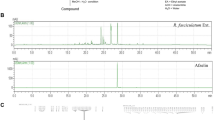Abstract
We report here the behavioral and biochemical recovery induced by the nerve growth factor (NGF) administration in AF64A-treated rats. Retention in the passive avoidance test was affected by lesion but it was significantly improved after the NGF treatment. Similar results were observed in the performance during the Morris water maze (MWM) task. Remarkable losses in the ChAT activity were detected in some brain regions from lesioned rats. The NGF-induced alleviation of choline acetyltransferase (ChAT) activity losses and cognitive functions suggest a trophic and protective action on the remaining cholinergic neurons after the lesion. Thus NGF therapy could be considered as a possibility mainly in the early course of Alzheimer disease.
Similar content being viewed by others
References
Buresova O. and Bures J. (1983) Learning and memory, inTechniques and Basic Experiments for the Study of Brain and Behavior (Bures J., Buresova O., and Huston J., eds.), pp. 135–160, Elsevier Science, New York.
Chen K. S. and Gage F. H. (1995) Somatic gene transfer of NGF to the aged brain: behavioral and morphological amelioration.J. Neurosci. 15, 2819–2825.
Fernández C. I., Bergado J., de la Cuétara K., and Molina H. (1994) Brain aging and neurotransplantation. II. Effects of septal cell suspension graft to hippocampus of aged rodents on learning and memory disabilities.Arch. Gerontol. Geriatr. Supp. 4, 59–65.
Fonnum F. (1975) A rapid radiochemical method for the determination of ChAT activity.J. Neurochem. 24, 407–409.
Friedland R. P. (1993) Alzheimer's disease: clinical and differential diagnosis.Neurol. 43, 45–51.
Lamberty Y., Gower A. J., Gobert J., Hanin I., and Wulfert E. (1992) Behavioral, biochemical and histological effects of AF64A following injection into the third ventricle of the mouse.Behav. Brain Res. 51, 165–177.
Lapchak P. and Hefti F. (1992) BDNF and NGF treatment in lesioned rats: effects on cholinergic functions and weight gain,NeuroReport 3, 405–408.
Morley B. J. and Murrin L. (1989) AF64A depletes hypothalamic high-affinity choline uptake and disrupts the circadian rhythm of locomotor activity without altering the density of nicotinic acetylcholine receptors.Brain Res. 504, 238–246.
Varon S. and Hagg T. (1993) Models to evaluate effects of neurotrophic factors on axonal regeneration.Neuromethods 25, 371–405.
Walsh T. J. and Opello K. D. (1992) Neuroplasticity, the aging brain and Alzheimer's disease.Neurotoxicology 13, 101–110.
Walsh T. J. and Opello K. D. (1994) The use of AF64A (ethylcholine aziridinium ion) to model Alzheimer's disease, inToxin-Induced Models of Neurological Disorders (Woodruff M. L. and Nonneman A. J., (eds.), pp. 259–279, Plenum, New York.
Yamazaki N., Kato K., Kurihara E., and Nagaoka A. (1991) Cholinergic drugs reverse AF64A-induced impairment of passive avoidance learning in rats.Psychopharmacology 103, 215–222.
Author information
Authors and Affiliations
Rights and permissions
About this article
Cite this article
Ivette Fernández, C., González, O., Soto, J. et al. Effects of chronic infusion of nerve growth factor (NGF) in AF64A-Lesioned rats. Molecular and Chemical Neuropathology 28, 175–179 (1996). https://doi.org/10.1007/BF02815219
Received:
Revised:
Accepted:
Published:
Issue Date:
DOI: https://doi.org/10.1007/BF02815219




